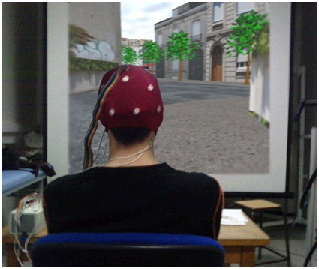Section: New Results
Brain-Computer Interfaces
Participants : Fabien Lotte, Florian Larrue, Martin Hachet.
As part of our research on Brain-Computer Interfaces (BCI), our contributions addressed two different levels: 1) the brain signal processing level, in order to design more efficient BCI systems and 2) the applications level, in order to propose and explore new BCI applications.
At the signal processing level, we explored and designed new features to represent ElectroEncephaloGraphic (EEG) signals. In particular we explored multifractal cumulants and predictive complexity features (which we published in the Neurocomputing journal [5] ), as well as waveform length features together with an optimal spatial filter that we designed for such features (which we published in the ICPR international conference [19] ). All these features proved useful to classify EEG signals, and, more importantly, increased the classification performances of the system when combined together with the gold standard features, namely, band power features. Thus, this contributed to extending the repertoire of features available to BCI designers as well as increasing BCI performances. Nevertheless, our studies of BCI and educational research led us to the conclusion that current BCI feedback training approaches (which aimed at teaching people how to use a BCI and how to control their own brain activity), are most probably highly inappropriate and one of the major causes for the limited performances of current BCI - maybe more than signal processing methods. We therefore stressed the need for alternative feedback training approaches for BCI in a publication at the international BBCI workshop [20] .
At the application level, we mostly focused on Virtual Reality (VR) related applications. Indeed, together with other groups in the field, we reviewed how BCI and VR could be combined in order to give rise to new applications and to improve BCI designs. This was published in a book chapter dedicated to BCI [22] . Similarly, with international colleagues, we reviewed and envisioned new applications of BCI outside the medical domain, and proposed guidelines to move towards these new applications. This notably includes VR and game applications, user-state monitoring, neuro-evaluation, training and education, cognitive improvement as well as safety and security. This was published in the IEEE Computer journal [8] . Finally, we proposed a new and innovative application of BCI: using it as a tool to study spatial cognition and transfer from VR to real environments. In particular, since BCI can be used to navigate a Virtual Environment (VE) without any motor activity, BCI can be used to assess how much motor activity is really needed to transfer spatial knowledge from a VE to a real one. This is what we did by comparing a BCI and a treadmill in order to teach users a path in a VE and then asking them to retrieve this path in the real world. Contrary to what was believed before, our results showed that motor activity is not necessary to learn a path in VR. We showed that what is really necessary is performing an action, but that this action does not have to be motor, and can be, for instance, cognitive (e.g., imagining hand movements), with a BCI. This was published in the VRST international conference [14] .
|



